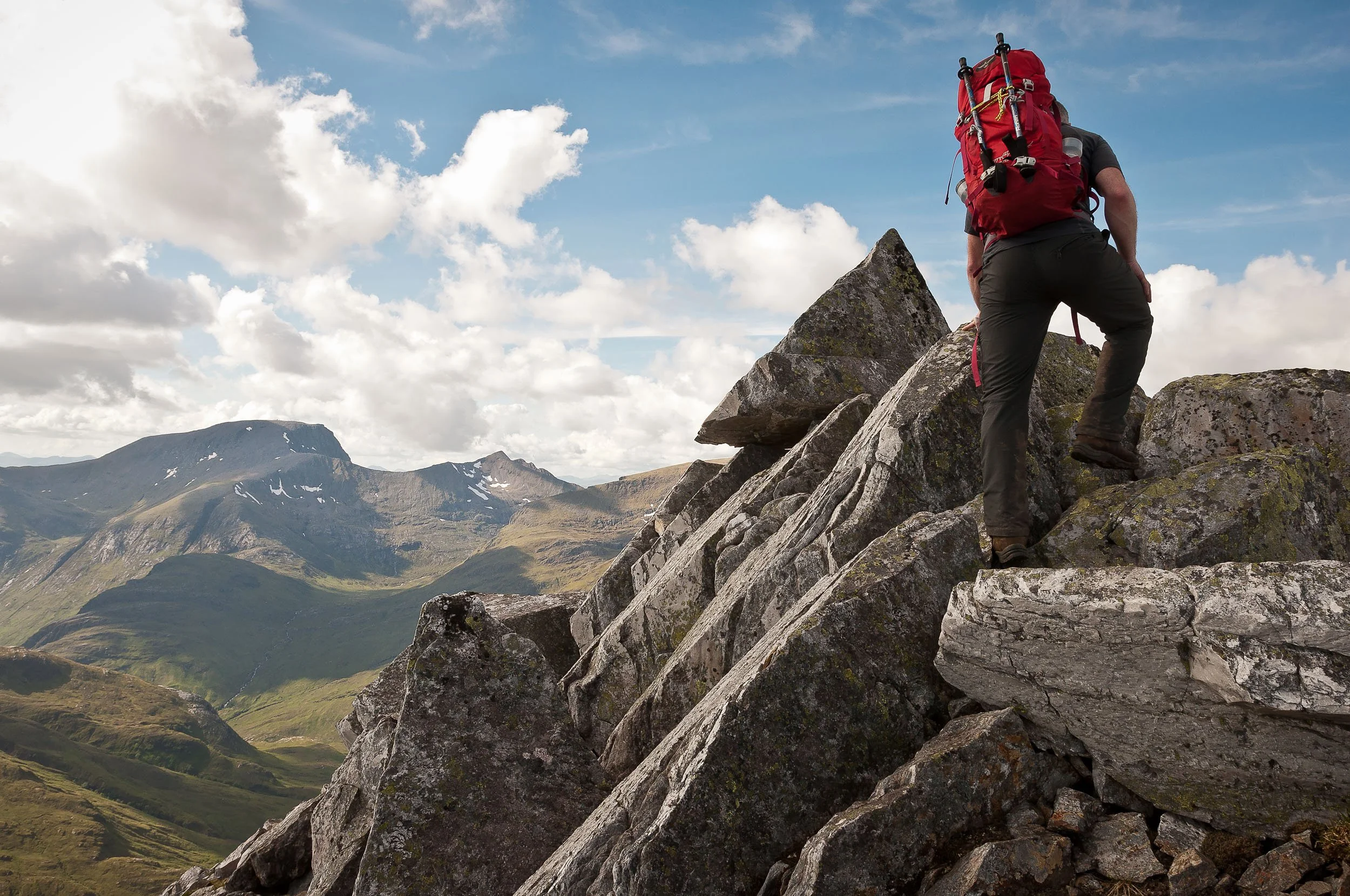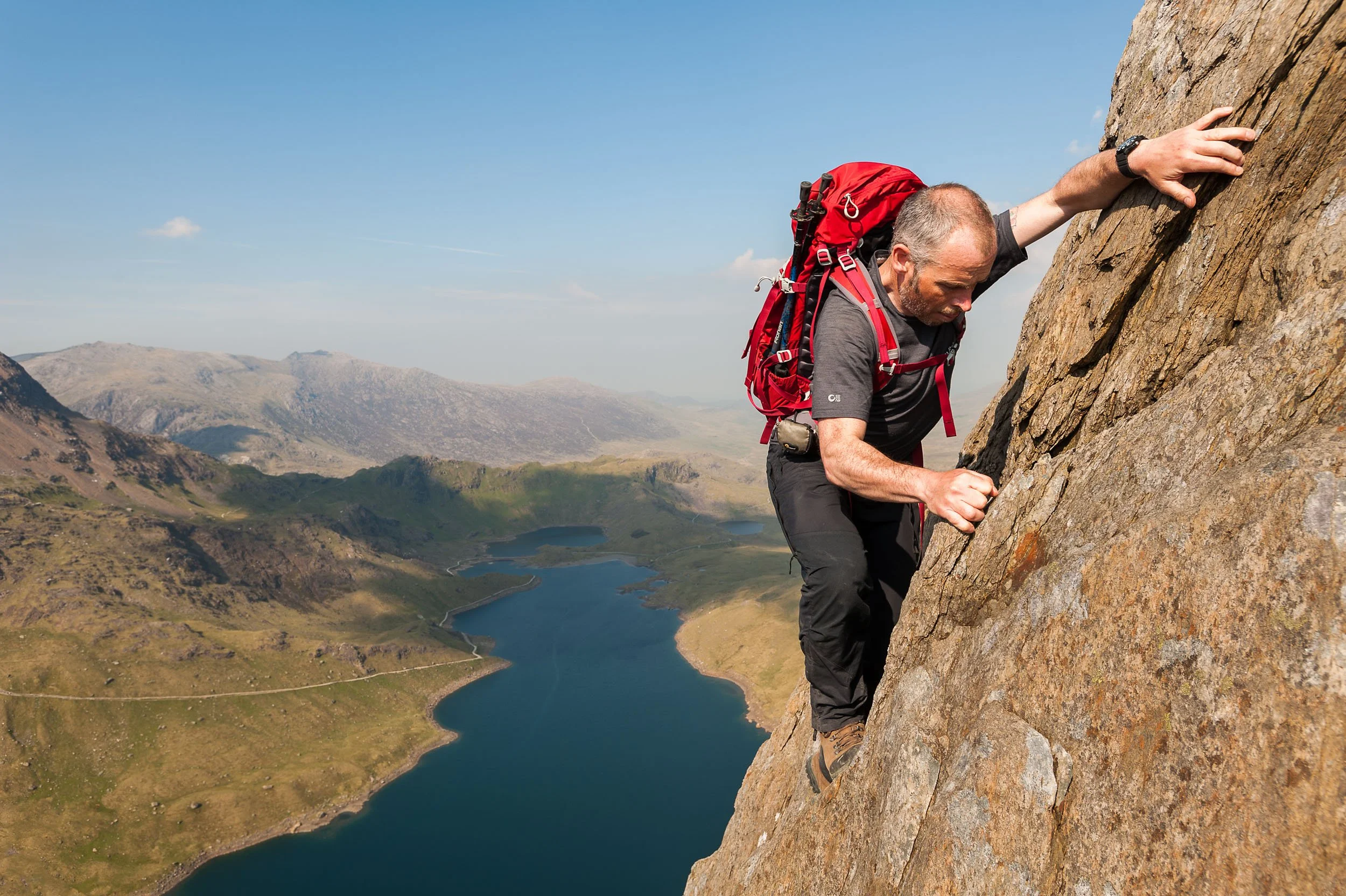Blog
Occasionally, I like to write to complement my photography (primarily for myself but also with the outdoor community in mind). If I’m fortunate enough, and I’ve put the effort in, my thoughts make their way into print.
Weekend Wonder - Winter hiking on Streap
It’s not all about Munros. Winter hillwalking on a Corbett in the West Highlands of Scotland.
Published in Adventure Travel magazine as part of regular material I created for their ‘Weekend Wonders’ feature.
My first sighting of Streap, a superb, 909m high Corbett in the West Highlands of Scotland, was on a 6-day backpacking adventure in 2010 from Glen Shiel to Glenfinnan, when a friend and I followed part of Scotland's epic Cape Wrath Trail. After I returned home, a paragraph in Ralph Storer's classic book, '100 Best Routes on Scottish Mountains', which highlighted Streap's narrow summit ridge "should be left well alone by the inexperienced" continued to intrigue me over the years.
David Hetherington traverses a snowy ridge on Streap in the West Highlands of Scotland
In February 2016, I finally organised a visit to Streap. The weather forecast was excellent and we spent a great two nights in Gleann Dubh-Lighe bothy, trekking on snow-covered slopes through the day beneath a clear blue sky in temperatures that remained, pleasantly, well below freezing.
Ralph Storer was right. In poor weather, you'll need top-notch navigation skills to steer yourself through Streap's complex, craggy bluffs and its steep-sided, narrow arete demands caution all the way to the summit. On a nice day, the difficulties are slight and the ridge is simply awesome, with just the right amount of awkward terrain to keep your interest and incredible views - south-east to Ben Nevis and north-west out to the islands of Eigg, Rum and the Skye Cuillin.
Streap is an outstanding hill. We paired it up with an ascent of Streap Comhlaidh and another Corbett, Braigh nan Uamhachan, completing a round trip of ‘feet in front of the bothy fire’ to 'feet in front of the bothy fire’ of 12 hours (our slowness in part due to being hampered by deep snow). In Winter or Summer, you should find it's an excellent day out.
How to get there
Take a train, bus or car from Fort William to Glenfinnan. Roughly 3km south-east of Glenfinnan, just west of the bridge over the Dubh-Lighe river, a turn-off north leads uphill to a small public car park. From here, OS Landranger map 40 (Mallaig & Glenfinnan, Loch Shiel) and OS Explorer map 398 (Loch Morar & Mallaig) both cover the approach to Streap via the quiet highland glen, Gleann Dubh-Lighe.
Where to stay
Fort William and Corpach are obvious choices. Glenfinnan has a quirky bunkhouse - check out www.glenfinnanstationmuseum.co.uk. If you’re looking for more rustic accommodation, the bothy in Gleann Dubh-Lighe is maintained by the Mountain Bothy Association (www.mountainbothies.org.uk). In 2011, the building was accidentally burnt down when a leaky gas cartridge caught fire. In 2013, it was rebuilt by MBA volunteers.
Weekend Wonder - Tackling Tranter’s Round
A feature on walking and backpacking Tranter's Round in the West Highlands of Scotland.
Published in Adventure Travel magazine as part of regular material I created for their ‘Weekend Wonders’ feature.
A natural progression if you enjoy backpacking trips is to look for opportunities to link different routes together, increasing length and difficulty to set yourself a challenge. One such opportunity is Tranter's Round in the Lochaber region of Scotland.
David Hetherington on Binnein Mor in the Mamores, West Highlands of Scotland
Tranter's Round is named after Philip Tranter, son of the Scottish author, Nigel Tranter, who in 1964 devised a 24-hour challenge for fell runners when he connected (at the time) 19 Munros in the West Highlands of Scotland (the Mamores, Grey Corries, Aonach Mor and Aonach Beag, Carn Mor Dearg and Ben Nevis) in a 36-mile epic that covers 20,600ft of ascent. Tranter's Round is a fell runner's classic (superseded these days in terms of difficulty by a longer Charlie Ramsay Round, and with a demoted Munro) but it's a route that's also tailor made for backpacking.
To give us a head start on our attempt at backpacking Tranter's Round, we bivvied on a damp summit of Mullach nan Coirean in the Mamores at 2300 hours. Early the next morning, we continued over the Mamores, ticking off the peaks of Stob Ban, Sgurr a'Mhaim and Am Bodach. I didn't go out to An Gearanach, choosing to dry my sleeping bag in the sunshine instead, but Na Gruagaichean soon came next, then Binnein Mor, Binnean Beag and Sgurr Eilde Mor. Sixteen hours after we started out we descended and spent the night at Meanach bothy, having climbed 10 Munros.
Our return leg on day two is commonly called the Lochaber Traverse. First we ticked off the Grey Corries, starting with Stob Ban then Stob Choire Claurigh, Stob Coire nan Laoigh and Sgurr Choinnich Mor. A steep, grassy scramble then took us up onto a very wintry Aonach Beag. It was here that we decided to cut our trip short. A storm that had been distant for much of the afternoon brought in 50mph winds and freezing rain and, in true Scottish style, what had been a pleasant Summer's day turned distinctly nasty with a great risk of hypothermia. None of us are new to bad weather but with eight hours in, three Munros to do (including Britain's highest mountain) and a sharp scrambly ridge between them, it wasn't hard to make the decision to bail over Aonach Mor and descend to the roadside. Despite our disappointment, it was a great outdoor trip. Tranter's Round proved to be a very worthy backpacking route.
Travelling light
The current fastest known time for Tranter's Round, set on 01 June 2024, is 8 hours 27 minutes 53 seconds by Fort William-based GP, Finlay Wild. Although such a fast time will be unachievable (or undesirable) for most, adopting a hill running ethos for backpacking Tranter's Round isn't a bad idea. Travelling with as little gear as possible will be easier on your knees.
Navigation
Harvey Maps publish a map for the Charlie Ramsay Round, which includes the same peaks and is ideal for Tranter's Round. The route is also covered on Ordnance Survey Landranger map 41 (Ben Nevis, including Fort William & Glen Coe). You can choose to go clockwise or anti-clockwise. The latter has the distinction of finishing on Britain's highest mountain.
Weekend wonder - Creach Bheinn
Ascending the Corbett Creach Bheinn near Oban, submitted as part of a regular Weekend Wonder feature in Adventure Travel magazine.
Published in Adventure Travel magazine as part of regular material I created for their ‘Weekend Wonders’ feature.
Looking over to Ben Starav from the frozen snow slopes of Creach Bheinn in the West Highlands of Scotland.
Despite the number of years I’ve spent walking and scrambling in Scotland’s hills, I’ve always been excited when making plans to visit a new location. Researching different ways for how I can ascend a mountain gives me an opportunity to consider what’s around the area and establish whether I’ll be able to see familiar hills nearby from a different perspective.
An example of this was an ascent we made of Creach Bheinn, a Corbett near Oban in the West Highlands of Scotland. I’ve climbed its neighbour, the Munro Beinn Sgulaird, multiple times but it wasn’t until the prompting of a friend who is completing his Corbetts that I showed any interest in Creach Bheinn. We were based in Oban for the weekend and I was due to catch up with other friends of mine who were visiting from Alaska. They’d never been on a Scottish hill before so the obvious choice was to take them up a Munro. Our plan was we would climb Beinn Sgulaird first and extend our day to include Creach Bheinn. Unfortunately (okay, not really) we had great weather and the number of extended stops we made for photographs meant we ran out of time and we agreed to return the following day.
In the morning, our good fortune with the weather had continued. The steep ascent from Loch Creran to the bealach at the head of Coire Buidhe passed quickly and the views we had during our ascent to Creag Bheinn’s summit were superlative. At the summit trig point, if we faced West and turned clockwise we could see over the sea to the Isle of Mull. In a northerly direction, there was Ardgour and Ben Nevis plus expansive views further East, all the way inland to the Tyndrum hills. Further south, we had great views into the back of the Ben Cruachan group but perhaps our best view was north-east to Glen Etive, where we could see all the way down the glen towards Glencoe and Buachaille Etive Mor. I’m no stranger to Glen Etive, having visited it on many an occasion when I’ve climbed the Munro, Ben Starav, but I’ve always entered the glen from its northern end. The view we had of Ben Starav during our descent of Creach Bheinn was from across the southern end of the glen, over the head of Loch Etive. I'd never seen Ben Starav from this perspective and I wasn’t aware of the obvious rock buttresses that sit right beneath its summit. They reminded me of the mighty Triple Buttress on another Scottish Munro, Beinn Eighe.
Getting there and around
Oban is easily accessible from Glasgow, either by rail (www.scotrail.co.uk) or by car (head to Tyndrum on the A82 and then west on the A85). Creach Bheinn is only really accessible by car. From Oban, drive the A85 north to Connell and cross the bridge to Benderloch. Continue on the A85 to South Creagan and, before you cross the bridge, turn left at the roundabout and follow the road along the south shore of Loch Creran to reach Druimnavuic. From there, you’ll want to switch into standard hillwalking gear (e.g. warm clothes, waterproofs and gloves) plus be experienced in the use of a map (Ordnance Survey Explorer 377 Loch Etive & Glen Orchy) and a compass.
Places to stay
Oban has plenty of options for accommodation, from B&Bs and hotels to a Youth Hostel with great sea views (www.syha.org.uk). For longer stays, consider Bonawe Holiday Cottages near Taynuilt (www.bonawehouse.co.uk). These self-catering cottages are owned and managed by a former long-standing team leader of Oban Mountain Rescue Team.
Weekend wonder - Snowdon scrambles
Two scrambling options in Snowdonia National Park, published as a Weekend Wonder in Adventure Travel magazine.
Published in Adventure Travel magazine as part of regular material I created for their ‘Weekend Wonders’ feature.
David Hetherington scrambling on rocky slabs high above Llyn Llydaw during an ascent of Y Lliwedd on the Snowdon Horseshoe.
Living in Edinburgh, my built-in compass usually sees me heading north when I have time off - Scotland’s hills are very hard to resist - and I've headed south in the UK only twice before. Thick mist and rain one November spoiled the view for us in the Lake District and at times we counted ourselves lucky we could even see each other on the hill. On my second trip, we spent 3 days walking and scrambling with friends in Wales in Snowdonia National Park. Thankfully, there was no rain forecast and we expected 25 degree C temperatures.
Snowdonia National Park is a perfect place to visit for mountain walking, especially if you’d like to test your scrambling skills. Early on in my hiking and backpacking ‘career’, I had a bad experience whilst scrambling. I can’t recall which mountain I was on but I was in the North-West Highlands of Scotland and I clearly recall being stuck on the side of a ridge in a position where I didn’t want to go up and I didn’t want to go down. Numerous attempts at alleviating the situation failed and I had my first (and only) experience of ‘sewing machine leg’ where your leg involuntarily shakes and you feel like you are going to fall off the mountain. On that occasion, I was gratefully assisted by a friend physically moving my foot to an unseen foothold but it set in motion for me a somewhat irrational fear I have of falling when I’m on technical ground. Since then, I’ve often been wary of putting myself into exposed situations but I do love the visual aspect of a mountain ridge and scrambling along one is as fine a way as any to reach or descend from the summit of a mountain.
We started our Welsh trip with a scramble around the Snowdon horseshoe. This classic route traverses the excellent Crib Goch, at times a knife-edge ridge that led us to the summit of Yr Wyddfa, or Snowdon, Wales’ highest mountain. The horseshoe continues over Y Lliwedd and returns you to Pen y Pass. It’s a long day out but you’re almost guaranteed peace and quiet once you’ve left behind the drama of the number of people on Snowdon’s summit. The next day we drove round to the beautiful Ogwen Valley and climbed the north ridge of Tryfan, a route that the British Mountaineering Council calls ‘a long and thrilling grade one scramble that makes a perfect introduction to the sport’. On the summit, the brave can leap from two large rocks called Adam to Eve to test their mettle even further. We continued over the spectacularly spiked rocks of Glyder Fach to Glyder Fawr before we descended a really fun route on Y Gribin. This entertaining ridge, which led us back to our car via a refreshing mountain lake, provided us with great views back to the route we’d descended off Tryfan.
Looking after yourself
Snowdonia National Park is covered by Ordnance Survey Explorer Snowdonia map set - OS Explorer Maps OL17 / OL18 / OL23. If you’re nervous about scrambling on your own, or with friends, consider a training course. You can learn the skills safely before venturing onto technical terrain. Plas Y Brenin (http://www.pyb.co.uk) is the national mountain sports centre and is located in Snowdonia National Park just outside Capel Curig.
Weekend wonder - Ladhar Bheinn, Knoydart
A summary of the Munro Ladhar Bheinn in Knoydart, published as a ‘Weekend Wonder’ feature in Adventure Travel magazine.
Published in Adventure Travel magazine as part of regular material I created for their ‘Weekend Wonders’ feature.
Scrambling the south-east ridge of Ladhar Bheinn, with Coire Dhorrcail on the right
Ladhar Bheinn is one of my favourite Scottish mountains – partly because it is only accessible by boat or by foot. Getting there usually involves travelling 9km by boat from Mallaig to the small settlement of Inverie (popularly known as the home of Scotland's most remote mainland pub) or hiking around 13km of rough terrain from Kinloch Hourn, itself accessed via 35km drive along a single-track road.
I've climbed Ladhar Bheinn three times. I’m not a person of the mind that once a hill is climbed it's ticked off. Some hills deserve repeat ascents and I like to approach them from different sides and take time to explore the mountain. My first ascent of Ladhar Bheinn was from Inverie. We'd headed for Mam Barrisdale before breaking off up steep, fern-covered slopes onto the curious feature split ridge of Aonach Sgoilte. My second was during a four-day backpack of all the Munros in Knoydart, when we reached Aonach Sgoilte after first climbing two nearby Corbetts, Beinn na Caillich and Sgurr Coire Choinnichean. Both visits were in excellent weather and we savoured the warmth of the sun and some great views as we scrambled up the north-west ridge of Ladhar Bheinn to its summit.
My last visit to Ladhar Bheinn was in 2017. Clad in waterproofs, hat and gloves to combat the cold Spring weather, we hiked the classic route up the mountain, a route which navigates the horseshoe-shaped rim of Coire Dhorrcail. The headwall of this great mountain corrie is ringed with crags and enclosed by two great, narrow, steep-sided ridges, Stob a' Chearcaill and Stob a’ Choire Odhair. Although the Knoydart peninsula is known as the 'rough bounds' for the wild nature of its terrain, the ground isn't too challenging and we gained height quickly ."What an awesome location", I recall saying as we crested the corrie headwall and broke out onto Ladhar Bheinn's north-west ridge.
Ladhar Bheinn's summit flanks provide a fantastic viewpoint. As well as the views over Loch Hourn, you can see south-east to the neighbouring Munros, Luinne Bheinn and Meall Bhuide, and west out over the Corbett of Sgurr Coire Choinnichean towards Mallaig. Ladhar Bheinn's rocky north-west ridge is also great fun, with a few Grade 1 scrambling opportunities but nothing overly technical or exposed. There's also the opportunity stand on an obvious prow of rock halfway up that overhangs a drop of several hundred feet and has great views down Loch Hourn. It's quite a special place.
Getting there
Take the train, bus or drive from Fort William to Mallaig. A ferry at the port (www.calmac.co.uk and others) will sail you across the lower Sound of Sleat to Inverie. Alternatively, drive the A82 from Fort William and head for Invergarry. Turn onto the A87 and, not long after, follow the singletrack road west past Loch Garry and Loch Quoich to reach Kinloch Hourn.
Where to stay
Outside the comforts of Inverie (where you'll find B&Bs, a hotel and bunkhouse plus luxury self-catering accommodation), there are three overnight options for climbing Ladhar Bheinn. You can wild camp almost anywhere, courtesy of Scotland's refreshing outdoor access code, or stay in one of two private bothies nearby, Barisdale bothy or Druim bothy. Neither is maintained by the Mountain Bothy Association and both charge a fee for accommodation, with Druim requiring booking in advance.
More information: http://www.visitknoydart.co.uk
Map: OS 1:50,000 Landranger sheet 33 (Loch Alsh, Glen Shiel and Loch Hourn)










